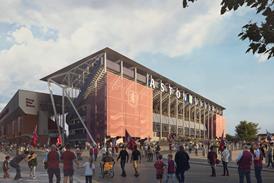Public sector tendering processes are too often a waste of time and money for all involved. Chloë Phelps shares her ideas for how to make the system start delivering

Procurement of architectural services by the public sector is one of the most complex, mind boggling and resource draining processes for a practice interested in delivering social housing. You need a PhD (or willingness to engage in AI) to be able to triangulate the complex structure of information across multiple files to even begin to understand what is required, and that’s before you start the internal practice debate on the semantics of the questions.
It is not an easy process to get projects off the ground within councils either. Officers have to bring multiple departments together, identify funding streams and then navigate cabinet report production and approvals, before they even start to think about procurement. Architects who bid for the work have come to accept it as a cost. But a cost to what? Alex Ely recently wrote a post on the monetary cost to the businesses and the impact this will have on our ability to invest in design quality and social value. I think the impacts go far beyond this.
I’ve seen some procurement horrors in my time on both sides of the fence, as client design advisor and as architect responding to the tenders. I’ve witnessed a new design for a school being procured where it probably, because officer time was stretched, took the best part of 12 months from production of the brief to the award of contract, only for it to be cancelled on that particular site because it required the acquisition of a building that was no longer supported.
That is an extraordinary loss of resources for the five businesses tendering, but also the time spent by multiple council officers on the project. The cost of this to the public purse is never measured. I’m pretty sure this is not an isolated incident in the 317 local authorities in the UK.
There is also the usual exceptionally long ‘wish list’ of brief requirements for marginally viable schemes. Typically a brief might be presented as an opportunity for an SME (small and medium sized enterprises) to bid for a project to design ten new homes on a garage site. It should of course be net zero, Passivhaus and built from low embodied energy materials with off site construction methods, whilst delivering social value through all stages of the project and optimising housing numbers. All to be built for a budget equating to £225,000 per home.
We all jump through the hoops to win the tender, but we know there is a conversation to be had that the budget is just too tight on day one. Yes, we can innovate to keep the costs as low as possible and come up with savvy ways to achieve the project brief, but ultimately this project has a high risk of stalling due to the unrealistic expectations that are stacked against it.
If we as a country are going to have a chance of realising the 1.5 million much needed new homes, unlocking planning and the NPPF is only one part of the puzzle. Public and private sectors need to work together to make sure we are making the best use of our resources and to be as efficient as possible to maximise the number and quality of schemes that are getting off the ground.

These are my asks:
1. Create best practice brief templates shared between public sector organisations that are direct and to the point and in plain language. It should be possible to write an outline brief to obtain a price that does not extend beyond two pages. If additional appendices are necessary, be clear if they are for information only, or something that is to be formally responded to as part of the tender process.
2. Utilise software and AI to automate the creation of bespoke briefs from standardised components.
3. Ensure the brief is deliverable and viable with margin for the unexpected.
4. Have a process for understanding the risk to the public purse and businesses as part of the project initiation process. If it does not adequately pass, do not pass that risk on to external businesses.
5. Acknowledge that appointing small and micro enterprises locally is often fulfilling a large part of the social value aspect of a project, and be proportionate and specific with how businesses can contribute to existing initiatives.
6. Market test the brief and always assess how easy it is to interpret. If in doubt employ the services of a client design advisor to assist.
7. Be clear what ‘good quality’ means to the organisation; does it mean long term ease of management and robustness, liveable and flexible homes or highly detailed building façades, or all of the above?
8. Be proportionate in the design thinking you are asking for as part of the invitation to tender (ITT). This is work we are providing for free. Asking for our approach to how we would design something is sometimes as much work as designing it. Focus on asking about our existing delivered projects as much as possible.
9. Use the brief writing process to bring conflicting council departments together to resolve knotty problems that can slow things down once the design aspect of the project has started.
Ultimately public procurement is about driving best value for money, and at the moment the ITT process is severely limiting our efficiency to accelerate the housing we need and our ability to use the money that is spent on these projects to boost local economies and invest in people. Lets make it easier to do these things.
















3 Readers' comments